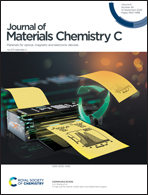Two-dimensional metal dicyanamide frameworks of BeTriMe[M(dca)3(H2O)] (BeTriMe = benzyltrimethylammonium; dca = dicyanamide; M = Mn2+, Co2+, Ni2+): coexistence of polar and magnetic orders and nonlinear optical threshold temperature sensing†
Abstract
We report the synthesis, crystal structures, and thermal, optical and magnetic properties of three new metal dicyanamide frameworks comprising benzyltrimethylammonium cations (BeTriMe+) as labile guests. These compounds crystallize in two-dimensional noncentrosymmetric structures, in space group Pna21 of the orthorhombic system, in which metal cations coordinate to five N atoms from dicyanamide anions and one oxygen atom from the water molecule. Magnetic studies indicate that Mn, Co and Ni compounds order at 2.5, 2.8 and 7.0 K, respectively. Second harmonic generation (SHG) and density functional theory (DFT) studies performed for BeTriMe[Mn(dca)3(H2O)] confirm a noncentrosymmetric structure. DFT computations also provide insights into the experimentally observed low-temperature magnetic order and insulating behavior. Thus, the synthesized compounds are rare examples of dicyanamide frameworks exhibiting coexistence of polar and magnetic orders, and additionally – SHG activity. Optical studies indicate that BeTriMe[Mn(dca)3(H2O)] also exhibits red emission under 450 nm excitation. Thermal studies reveal that BeTriMe[M(dca)3(H2O)] networks dehydrate near 350–380 K resulting in structural transformations. The anhydrous BeTriMeMn also exhibits SHG activity, which is about 4 times smaller compared to the hydrated analogue. On direct contact with air the anhydrous BeTriMeMn spontaneously rehydrates, restoring the SHG response to initially observed intensity. On the other hand, if the dehydrated BeTriMeMn is sealed from air, its SHG response is essentially irreversible and stable for days. Taking BeTriMeMn as an example we demonstrate that noncentrosymmetric compounds with effectively irreversible temperature-induced change of SHG response can be potentially employed as remote nonlinear optical (NLO) markers (NLO threshold temperature sensors). The usefulness of non-contact NLO markers of this kind is based on the fact that they can inform on the thermal history of a given object, specifically, by showing whether a certain threshold temperature was achieved or not.
![Graphical abstract: Two-dimensional metal dicyanamide frameworks of BeTriMe[M(dca)3(H2O)] (BeTriMe = benzyltrimethylammonium; dca = dicyanamide; M = Mn2+, Co2+, Ni2+): coexistence of polar and magnetic orders and nonlinear optical threshold temperature sensing](/en/Image/Get?imageInfo.ImageType=GA&imageInfo.ImageIdentifier.ManuscriptID=D0TC02794D&imageInfo.ImageIdentifier.Year=2020)


 Please wait while we load your content...
Please wait while we load your content...